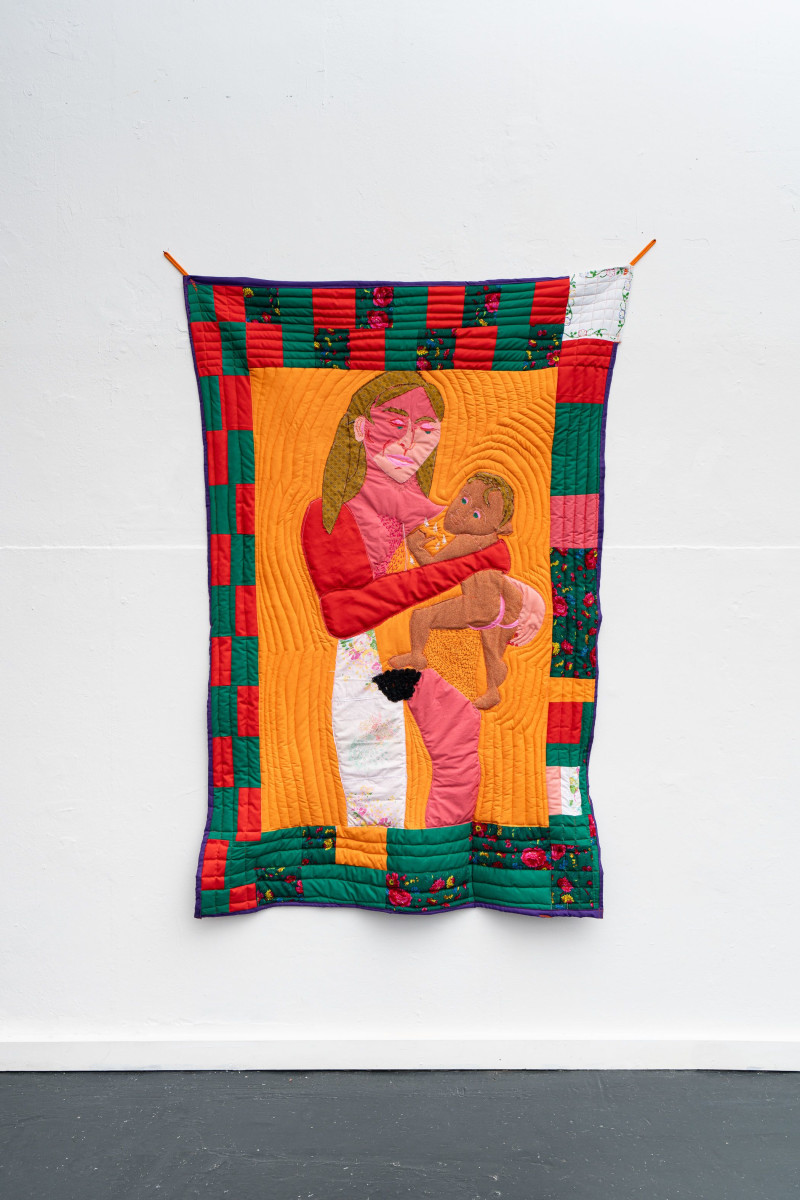09 december 2024, Wouter van den Eijkel
When Roots Start Riding Horses
In her solo exhibition When Roots Start Riding Horses, Carmen Schabracq explores the origin of her surname. She focuses not only on the past, but also considers which stories are worth passing on. With When Roots Start Riding Horses, she takes a new step in an oeuvre full of colourful work rooted in folk art and ethnographic traditions. This time, her focus is on the saddle pad, the ‘schabrak’.
Almost every field has its own jargon that sounds foreign to outsiders. Some terms reach the masses, such as ‘blazer’ and ‘pastry’. This does not apply to the word ‘schabrak’, which originates from the equestrian world. Once the sole means of transport, horses are now mainly used for police work, leisure and sports. Whereas outsiders speak of a horse blanket or saddle pad, insiders still use the term ‘schabrak’. That word was common around 1700, when it was written as ‘schabracq’. It is also Carmen Schabracq's surname, derived from the distorted name of the town where her Jewish ancestors lived before moving to Amsterdam — the Bohemian town of Zebrak, located between Prague and Pilsen. In Yiddish, the town name was likely pronounced as ‘sjebrak’. On arrival in the Dutch Republic, their name was changed to Schabracq, meaning saddle pad.

Carmen Schabracq, Migrating Root, 2024, Galerie Fleur & Wouter
Two pegasi with a schabrak
Nowadays, forms of folk art and ethnographic traditions receive considerable attention, but Carmen Schabracq (NL, 1988) had an eye for them back in art school. Masks in particular piqued her interest, as they are a cultural expression found worldwide. During a group exhibition earlier this year featuring five artists who gave a modern twist to ethnographic objects, she based her work on Mexican and Bulgarian masks. Schabracq works in various media: she draws, paints, does ceramics, often works with textiles and is certainly not shy about using colour.
With When Roots Start Riding Horses, Schabracq adds quilts to her repertoire. This medium, currently popular among artists and curators due to its association with emancipation history, was long considered secondary. The image on her quilt resembles the Madonna and child. More broadly, it addresses the mother-child relationship, reflecting Schabracq's own experience of becoming a mother a few years ago.

Carmen Schabracq, Mother Love, 2024, Galerie Fleur & Wouter
The birth of her child prompted her to delve into her family history and re-evaluate the stories passed down through generations. The gallery features a drawing of a family crest with a hand, diamond (a reference to the crafts practiced by the Schabracqs), and two pegasi adorned with saddle pads instead of wings. She also created a mask depicting the tragic fate of a 19th-century ancestor who drowned in an Amsterdam canal at a young age, leaving behind seven small children.

Carmen Schabracq, Pelgrimage, 2024, Galerie Fleur & Wouter
Central to When Roots Start Riding Horses is the significance of Schabracq's surname, the saddle pad. Inspired by this theme, she undertook a residency earlier this year at the textile centre Lotto Zero in Prato, Tuscany's textile hub. An hour away is Siena, home to the annual Palio horse race in July and August. Each district has its own flag and emblem featuring patterns of two or more colours and symbols like birds, fish, olive trees and dragons. Riders and horses are adorned in these colours, making it clear to spectators who is in the lead.
Although horseback riding is considered an elite sport nowadays, the saddle pad can be viewed as an ethnographic object or folk art. Like the saddle pads in the Palio, one of Schabracq's saddle pads incorporates references to her family, such as red hands and Stars of David. "It’s also a reference to my family’s migration history, which wouldn’t have been possible without horses. The horse cloth symbolises migration, a theme found in almost every family history."

Carmen Schabracq, Gracia, 2024, Galerie Fleur & Wouter
Past and future
Schabracq's focus is not only on the past; she also looks to the future with a saddle pad depicting a birthing woman. She plans to create 10 or 20 of these saddle pads, which she envisions placing on horses walking in a circle, turning the work into a performance. "You’d be surrounded by a tree of life made up of birthing women," Schabracq imagines. If that proves unfeasible, she plans to install them in a large space arranged in a circle. "This feels like the beginning of a much larger work."
Carmen Schabracq’s When Roots Start Riding Horses can be seen at Galerie Fleur en Wouter through 22 December.
Carmen Schabracq will be interviewed by art historian Cathelijne Blok in the gallery on Thursday, 19 December, at 7:00 PM.

Carmen Schabracq, When Roots Start Riding Horses, Galerie Fleur & Wouter
